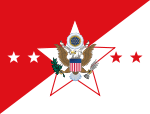Anthony Wayne
| Anthony Wayne | |
|---|---|
 | |
| Member of the U.S. House of Representatives from Georgia's 1st congressional district | |
|
In office March 4, 1791 – March 21, 1792 | |
| Preceded by | James Jackson |
| Succeeded by | John Milledge |
| Personal details | |
| Born |
January 1, 1745 Easttown Township, Province of Pennsylvania |
| Died |
December 15, 1796 (aged 51) Fort Presque Isle, near Erie, Pennsylvania |
| Resting place | St. David's Episcopal Church, Radnor, Pennsylvania |
| Political party | Anti-Administration party |
| Spouse(s) | Mary Penrose |
| Occupation | soldier |
| Military service | |
| Nickname(s) | Mad Anthony |
| Allegiance |
|
| Service/branch |
|
| Years of service |
1775–1783 1792–1796 |
| Rank |
|
| Battles/wars |
American Revolutionary War Battle of Trois-Rivières Battle of Brandywine Battle of Paoli Battle of Germantown Battle of Monmouth Battle of Stony Point Battle of Bull's Ferry Battle of Green Spring Northwest Indian War Siege of Fort Recovery Battle of Fallen Timbers |
Anthony Wayne (January 1, 1745 – December 15, 1796) was a United States Army officer, statesman, and member of the United States House of Representatives. Wayne adopted a military career at the outset of the American Revolutionary War, where his military exploits and fiery personality quickly earned him promotion to brigadier general and the sobriquet Mad Anthony. He later served as General in Chief of the Army and commanded the Legion of the United States.
Early life
Wayne was one of five children born to Isaac Wayne and Elizabeth Iddings Wayne in Easttown Township, near present-day Paoli, Chester County, Pennsylvania. His father had emigrated from Ireland, and was part of a Protestant Anglo-Irish family. Wayne was born on January 1, 1745, on his family's Waynesborough estate.[1] He was educated as a surveyor at his uncle's private academy in Philadelphia, as well as at the College of Philadelphia (now the University of Pennsylvania), where he was in the class of 1765, although he did not earn a degree. In 1765 he was sent by Benjamin Franklin and some associates to work for a year surveying land granted in Nova Scotia, and he assisted with starting a settlement the following year at The Township of Monckton.[2] In 1767 he returned to work in his father's tannery, while continuing work as a surveyor. He became a prominent figure in Chester County and served in the Pennsylvania legislature from 1774–80. He married Mary Penrose in 1766 and they had two children. Their daughter Margretta was born in 1770 and their son Isaac Wayne, future U.S. Representative from Pennsylvania, was born in 1772.[3]
American Revolution
At the onset of the war in 1775, Wayne raised a militia unit and, in 1776, became colonel of the 4th Pennsylvania Regiment. He and his regiment were part of the Continental Army's unsuccessful invasion of Canada where he was sent to aid Benedict Arnold, during which he commanded a successful rear-guard action at the Battle of Trois-Rivières, and then led the distressed forces on Lake Champlain at Fort Ticonderoga and Mount Independence. His service resulted in a promotion to brigadier general on February 21, 1777.
On September 11, 1777, Wayne commanded the Pennsylvania Line at Brandywine, where Wayne held off General Wilhelm von Knyphausen to protect the American right flank. The two forces fought for three hours until the American line withdrew, and Wayne was ordered to retreat.[4] Later, Wayne was ordered to harass the British rear in order to slow General Howe's advance towards Pennsylvania. Wayne's camp was attacked on the night of September 20–21, in the Battle of Paoli. General Charles Grey ordered his men to remove their flints and attack with bayonets in order to keep their assault secret.[5] The attack earned General Grey the nickname "No Flint," but the Americans used the tactics and casualties as propaganda regarding British brutality. General Wayne's own reputation was tarnished by the American losses, and he demanded a formal inquiry in order to clear his name.
Only days later, on October 4, 1777, Wayne again led his forces against the British in the Battle of Germantown. Wayne's soldiers pushed ahead of other American units, and, according to his report, when the British retreated, they "pushed on with their Bayonets – and took Ample Vengeance."[6] Generals Wayne and Sullivan advanced too quickly, however, and became entrapped when they reached two miles ahead of other American units. As General Howe arrived and reformed the British line, American forces retreated. General Wayne was again ordered to hold off the British and cover the rear of the retreating body.
After winter quarters at Valley Forge, Wayne led the American attack at the 1778 Battle of Monmouth. During this battle, Wayne's forces were abandoned by General Charles Lee and pinned down by a numerically superior British force. Wayne held out until relieved by reinforcements sent by Washington. Wayne reformed his troops and continued to fight.[7] Because the body of Lt. Colonel Henry Monckton was discovered by the 1st Pennsylvania Regiment, a legend grew that he had died fighting Wayne.
In July 1779 Washington named Wayne to command the Corps of Light Infantry, a temporary unit of four regiments of light infantry companies drawn from all the regiments in the Main Army.
Wayne's successful attack on British positions at Stony Point, New York in the Battle of Stony Point was the high point of his revolutionary war service. On July 16, 1779, Wayne replicated the bold attack used against him at Paoli, and personally led a bayonets-only night attack lasting thirty minutes. Wayne's three columns of light infantry stormed and captured British fortifications at Stony Point, a cliffside redoubt commanding the southern Hudson River. The success of this operation provided a boost to the morale of an army which had at that time suffered a series of military defeats. The Continental Congress awarded him a medal for the victory.
On July 21, 1780, Washington sent Wayne with two Pennsylvania brigades and four cannons to destroy a blockhouse at Bulls Ferry opposite New York City. In the Battle of Bull's Ferry, Wayne's troops were unable to capture the position, suffering 64 casualties, while inflicting only 21 on the loyalist defenders.[8]

On January 1, 1781, Wayne served as commanding officer of the Pennsylvania Line of the Continental Army when pay and condition concerns led to the Pennsylvania Line Mutiny, one of the most serious of the war. Wayne successfully resolved the mutiny by dismissing about one half of the line. Wayne largely returned the Pennsylvania Line to full strength by May 1781, but doing so delayed his departure to Virginia, where he had been sent to assist the Marquis de Lafayette against British forces operating there. The line's departure was delayed once more when the men again complained about being paid in the nearly worthless Continental currency.
In Virginia, Wayne led Lafayette's advance forces in an action at the 1781 Green Spring. Here, Wayne led a small scouting force of 500 to determine the location of Lord Charles Cornwallis, and fell into a trap. Once again, Wayne held out against numerically superior forces until reinforced by Major John Wyllys. Cornwallis then attacked, and Wayne – his forces now only at about 900 men – counterattacked.[9] Wayne led a bayonet charge against the British forces and then retreated in good order while night set in. This increased his popular reputation as a bold commander.
After the British surrendered at Yorktown, he went further south and severed the British alliance with Native American tribes in Georgia. He then negotiated peace treaties with both the Creek and the Cherokee, for which Georgia rewarded him with the gift of a large rice plantation. He was promoted to major general on October 10, 1783.
Political career
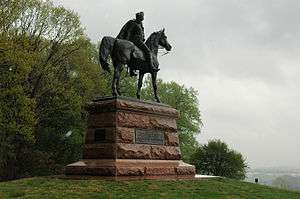
After the war, Wayne returned to Pennsylvania and served in the state legislature for a year in 1784. He then moved to Georgia and settled upon the tract of land granted him by that state for his military service. He was a delegate to the state convention which ratified the United States Constitution in 1788.
In 1791, he served a year in the Second United States Congress as a U.S. Representative of Georgia's 1st congressional district.[10] A House committee determined that electoral fraud had been committed in the 1790 election, and Wayne lost his seat over his residency qualifications. A special election was held on July 9, 1792, sending John Milledge to fill Wayne's vacant seat. Wayne declined to run for re-election in 1792.[11]
Northwest Indian War
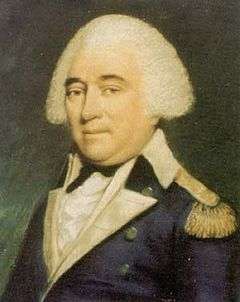
President George Washington recalled Wayne from civilian life in order to lead an expedition in the Northwest Indian War, which up to that point had been a disaster for the United States. Many American Indians in the Northwest Territory had sided with the British in the Revolutionary War. In the Treaty of Paris that had ended the conflict, the British had ceded this land to the United States. The Indians, however, had not been consulted, and resisted annexation of the area by the United States. The Western Indian Confederacy achieved major victories over U.S. forces in 1790 and 1791 under the leadership of Blue Jacket of the Shawnees and Little Turtle of the Miamis. They were encouraged and supplied by the British, who had refused to evacuate British fortifications in the region as called for in the Treaty of Paris.
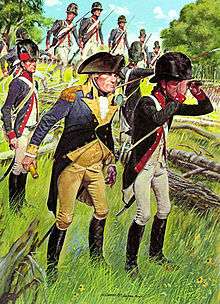
Washington placed Wayne in command of a newly formed military force called the "Legion of the United States". Wayne established a basic training facility at Legionville to prepare professional soldiers for his force. Wayne's was the first attempt to provide basic training for regular U.S. Army recruits and Legionville was the first facility established expressly for this purpose.
Wayne dispatched a force to Ohio to establish Fort Recovery as a base of operations, at the exact location of St. Clair's Defeat. The provocative fort became a magnet for military skirmishes in the summer of 1794. Wayne's army continued northward, building strategically defensive forts ahead of the main force. On August 3, 1794, a tree fell on Wayne's tent. He survived, but was rendered unconscious. By the next day, he had recovered sufficiently to resume the march to the newly built Fort Defiance.[12] On August 20, 1794, Wayne mounted an assault on the Indian confederacy at the Battle of Fallen Timbers, in modern Maumee, Ohio (just south of present-day Toledo), which was a decisive victory for the U.S. forces, ending the war. Wayne then continued to Kekionga, where he oversaw the construction of Fort Wayne.
Wayne then negotiated the Treaty of Greenville between the tribal confederacy and the United States, which was signed on August 3, 1795. The treaty gave most of what is now Ohio to the United States, and cleared the way for that state to enter the Union in 1803.
Wayne died of complications from gout on December 15, 1796, during a return trip to Pennsylvania from a military post in Detroit, and was buried at Fort Presque Isle (now Erie, Pennsylvania) where the modern Wayne Blockhouse stands. His body was disinterred in 1809 and, after the body was boiled to remove the remaining flesh, as many bones as possible were placed into two saddlebags and relocated by his son Isaac Wayne to the family plot in St. David's Episcopal Church cemetery in Radnor, Pennsylvania.[13] A legend says that many bones were lost along the roadway that encompasses much of modern U.S. Route 322, and that every January 1 (Wayne's birthday), his ghost wanders the highway searching for his lost bones.[14]




Legacy
On September 14, 1929, the U.S. Post Office issued a stamp honoring General Wayne which commemorated the 135th anniversary of the Battle of Fallen Timbers. The post office issued a series of stamps often referred to as the "Two Cent Reds" by collectors, most of them issued to commemorate the 150th anniversaries of the many events that occurred during the American Revolution and to honor people such as General Wayne and those others who were there during these times of struggle. The stamp shows Bruce Saville's Battle of Fallen Timbers Monument. Wayne earned the nickname "Mad" after his daring victory at the Battle of Stony Point. Wayne took 1,350 men scale the steep and rocky sides of Stony Point in the dead of night. He then had them only use their bayonets, not wanting to alert British sentries, and climbed over the walls of the fort. The battle lasted 25 minutes and ended with around 70 British dead and 550 prisoners taken to 15 killed for Wayne. Wayne earned a medal from Congress for his efforts and the legendary nickname of "Mad" Anthony Wayne.
Municipalities and institutions
There are many political jurisdictions and institutions named after Wayne, especially in Ohio, Michigan, and Indiana, the region where he fought many of his battles. Wayne County, NC was named after him.
Boroughs
- The Borough of Waynesboro, Pennsylvania
- The Borough of Waynesburg, Pennsylvania
Businesses, structures
- The former Anthony Wayne Bank in Fort Wayne
- Anthony Wayne Barber Shop in Maumee, Ohio
- Anthony Wayne, a campsite at Woodland Trails Scout Reservation in Camden, Ohio
- The Anthony Wayne Movie Theater in Wayne, Pennsylvania
- Anthony Wayne Recreation Area in Harriman State Park, New York
- AWS, formerly Anthony Wayne Rehabilitation Center for the Handicapped and Blind, Inc. in Fort Wayne, Indiana[15]
- Anthony Wayne Suspension Bridge near downtown Toledo, Ohio
- Anthony Wayne Terrace Housing Association Baden, Pennsylvania
- Mad Anthony Brewing Company, in Fort Wayne, Indiana
- Fort Wayne in Fort Wayne, Indiana
- Fort Wayne in Detroit, Michigan
- The Fort Wayne Mad Ants basketball team of the NBA Development League.
- General Wayne Inn in Merion, Pennsylvania
- "Mad Anthony's", a local pub in Waterville, Ohio
- Wayne Corporation defunct school bus manufacturer, originally Wayne Agricultural Works, then Wayne Works
- Wayne Hospital in Greenville, Ohio
- Anthony Wayne Hotel in Akron, Ohio, demolished in 1996
- Anthony Wayne Motel in Yellow Springs, Ohio on US Route 68
- General Wayne Inn, Honey Brook, Pennsylvania. on US Route 322
- Anthony Wayne Hotel in downtown Hamilton, Ohio renovated into the Anthony Wayne Apartments
- Hotel Wayne & restaurant, 1202 North Main Street, Honesdale, Pennsylvania 18431
- Mad Anthony's Bottle Shop & Beer Garden in Waynesville, NC
- Wayne Oil Inc. in Fort Recovery, OH
- Wayne IGA in Fort Recovery, OH
Cities
- The City of Fort Wayne, Indiana
- The City of Wayne, Michigan
- The City of Wayne, Nebraska
- The City of Waynesboro, Georgia
- The City of Waynesboro, Mississippi
- The City of Waynesboro, Pennsylvania
- The City of Waynesboro, Tennessee
- The City of Waynesboro, Virginia
- The Village of Wayne, Illinois
- The Village of Waynesburg, Ohio
- The Village of Waynesville, Ohio
- The Town of Waynesville, North Carolina
- The Town of Waynesville, Missouri
Communities
- The community of Wayne, Pennsylvania
- The community of Waynedale, Fort Wayne, Indiana
Counties
- Wayne County, Georgia
- Wayne County, Illinois
- Wayne County, Indiana
- Wayne County, Iowa
- Wayne County, Kentucky
- Wayne County, Michigan
- Wayne County, Mississippi
- Wayne County, Missouri
- Wayne County, Nebraska
- Wayne County, New York
- Wayne County, North Carolina
- Wayne County, Ohio
- Wayne County, Pennsylvania
- Wayne County, Tennessee
- Wayne County, West Virginia
Forests and parks
- Wayne National Forest in Ohio
- Anthony Wayne Recreation Area, part of Harriman State Park, in New York State
- Anthony's Nose, the mountain on the east end of the Bear Mountain Bridge near Peekskill, New York
- Wayne Square, in Tallahassee, Florida – present location of City Hall and one of 5 public squares established in the city's original plan
- Wayne Park in Beaver, Pennsylvania
Towns and Villages
- The town of Wayne, Maine
- The town of Waynesville, Missouri
- The town of Wayne, New Jersey
- The town of Wayne, New York
- The town of Waynesville, North Carolina
- The village of Wayne, Ohio
- The village of Waynesville, Ohio
- The town of Wayne, Oklahoma
- The town of Wayne, Pennsylvania
- The town of Wayne, West Virginia
- The town of South Wayne, Wisconsin
- The town of Mad River Township
- The City of Wayne, Michigan
- The town of Waynesville, Georgia
Schools and Colleges
- Anthony Wayne School in Philadelphia, Pennsylvania
- Anthony Wayne Elementary School in Defiance, Ohio
- Anthony Wayne –Elementary School in Franklin, Ohio
Wayne Trace High School in Paulding, Ohio
- Anthony Wayne Middle School in Wayne, New Jersey
- Anthony Wayne High School Whitehouse, Ohio
- Anthony Wayne Local Schools, Ohio, whose sports teams are known as the "Fighting Generals"[16]
- General Wayne Elementary School, in Malvern, Pennsylvania
- Wayne County High School, in Monticello, Kentucky
- Wayne Community Schools in Corydon, Iowa
- Wayne County Community College in Detroit, Michigan
- Wayne Elementary School Erie, Pennsylvania
- Wayne High School, Huber Heights, Ohio
- Wayne High School (Oklahoma), Wayne, Oklahoma
- Wayne High School, Fort Wayne, Indiana
- Wayne State College, Wayne, Nebraska
- Wayne State University, Detroit
- Waynesboro Area Senior High School, Waynesboro, Pennsylvania
- Waynesboro High School in Waynesboro, Virginia
- Waynesburg University in Waynesburg, Pennsylvania
- Waynesfield-Goshen Schools, Waynesfield, Ohio
- Anthony Wayne Elementary School in Detroit, Michigan
- Wayne Trail Elementary School in Maumee, Ohio
Mad River School District, Riverside, Ohio
- Anthony Wayne Elementary School in Ambridge, Pennsylvania
Wayne County High School (Waynesboro, Mississippi)
Streets and highways
- Anthony Street, Celina, Ohio
- Anthony Boulevard, Fort Wayne, Indiana
- Anthony Wayne Avenue, Cincinnati, Ohio
- Anthony Wayne Drive, in Detroit, Michigan
- Anthony Wayne Drive, in Baden, Pennsylvania
- Anthony Wayne Drive, in Chesterbrook, Pennsylvania
- Anthony Wayne Drive, Warminster, Pennsylvania
- Anthony Wayne Trail, in Toledo, Ohio
- Anthwyn Road, Merion, Pennsylvania (across from the inn)
- Mad Anthony Street, Cincinnati, Ohio
- Mad Anthony Street, Millersburg, Ohio
- North Wayne Avenue, Lockland, Ohio
- North Wayne Street, West Chester, Pennsylvania
- South Wayne Avenue, Fort Wayne, Indiana
- South Wayne Avenue, Lockland, Ohio
- South Wayne Street, West Chester, Pennsylvania
- Southwest Anthony Wayne Drive, Fort Wayne, Indiana
- Wayne Avenue, Ticonderoga, New York
- Wayne Avenue, Bronx, New York
- Wayne Avenue, Chambersburg, Pennsylvania
- Wayne Avenue, Collingdale, Pennsylvania
- Wayne Avenue, Chicago, Illinois[17]
- Wayne Avenue, Dayton, Ohio
- Wayne Avenue (Rte 112), Stony Point, New York
- Wayne Avenue, Philadelphia, Pennsylvania
- Wayne Avenue, Greenville, Ohio
- Wayne Street, Celina, Ohio
- Wayne Street, Fort Recovery, Ohio
- Wayne Street, Fort Wayne, Indiana
- Wayne Street, Toledo, Ohio
- Wayne Street, Erie, Pennsylvania
- Wayne Trace, Fort Wayne, Indiana
- Mad River Road, in Hillsboro, Ohio
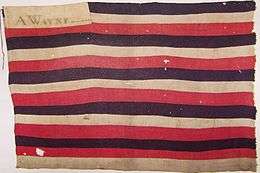
- Wayne Road, running through (from North to South) the municipalities of; Livonia, Westland, Wayne, and Romulus, Michigan.
Townships
- Wayne Township, Ohio
- Wayne Township, Illinois
- Wayne Township, Allen County, Indiana
- Wayne Township, Marion County (Indianapolis), Indiana
- The former Wayne Township, Montgomery County, Ohio (now the City of Huber Heights)
- Wayne Township, New Jersey
- Wayne Township, Lawrence County, Pennsylvania
- the former Mad River Township and Mad River Township Local School District (now Riverside, Ohio)
Villages
- The Village of Wayne, Illinois
- The Village of Waynesfield, Ohio
- The Village of Waynesville, Illinois
- The Village of Waynesville, Ohio
- The Village of Wayne City, Illinois
- The Village of Waynesburg, Ohio
Popular culture
Wayne's legacy has extended to American popular culture in a number of ways.
In literature and publications
- Wayne is mentioned in Donald Barthelme's novel, The King.
- Contrary to the popular belief that Bruce Wayne (the real name of the superhero character Batman) was named after John Wayne, comic book writer Bill Finger named Batman's alter ego after Robert the Bruce and Anthony Wayne.[20] In the DC Comics, Bruce Wayne is depicted as General Wayne's direct descendant. Furthermore, the property on which Wayne Manor is built was given to General Wayne for his service during the Revolution. Rumors that Bruce's middle name is "Anthony" have yet to be confirmed by DC Comics.
- In F. Scott Fitzgerald's Tender Is the Night (1934), Dick Diver mentions his descent from Mad Anthony Wayne.
- Anthony Wayne is one of the main characters in Ann Rinaldi's historical novel, A Ride into Morning.
- In J.D. Salinger's The Catcher in the Rye (1951), Mr. Spencer, one of the teachers at (fictitious) Pencey Prep School, lives across the street from campus on Anthony Wayne Avenue.
- Mad Anthony Wayne is a character in Diana Gabaldon's Outlander series. He features in An Echo In The Bone and Written In My Own Heart's B*
In products
- Mad Anthony Ale (Mad Anthony's APA), an American Pale Ale (APA) brewed by the Erie Brewing Company in Erie, Pennsylvania
Onscreen
- Actor Marion Michael Morrison was initially given the stage name of Anthony Wayne, after the general, by Raoul Walsh, who directed The Big Trail (1930), but Fox Studios changed it to John Wayne instead, saying "Anthony" sounded "too Italian". John Wayne was leading man in 142 of his 153 movies, more than any other actor in history.
- In "Guy Walks Into a Psychiatrist's Office...", the Season Two premiere of The Sopranos, the character Dr. Jennifer Melfi is shown seeing patients at the "Anthony Wayne Motel" in Wayne, New Jersey, while on the lam, in fear for her life.
- The 1971 made-for-TV movie Assault on the Wayne, starring Leonard Nimoy, takes place on board the submarine U.S.S. Anthony Wayne.[21]
- In Boardwalk Empire, S3E09, antagonist Gyp Rosetti admires a glass encased colonial hat from, as he says, "Mad Anthony Wayne". Rosetti later steals this hat at the end of the episode and wears it as he watches over his illegal alcohol business.
In sculpture

- General Anthony Wayne relief, by James Edward Kelly, Tryon, North Carolina, 1896
- The Wayne County Building in Detroit, Michigan, features a pediment by Edward Wagner that depicts an equestrian Wayne, c. 1900
- Equestrian statue by Henry Kirke Bush-Brown at Valley Forge, 1908
- Anthony Wayne Monument by George Etienne Ganiere, Fort Wayne, Indiana, 1918
- Battle of Fallen Timbers Monument also known as the Anthony Wayne Monument, by Bruce Saville, Maumee, Ohio, 1929
- Equestrian statue by John Gregory, Philadelphia, Pennsylvania, 1937
In transportation

- The Gen. "Mad" Anthony Wayne, a side-wheel steamboat, sank in April 1850 in Lake Erie while en route from the Toledo, Ohio, area to Buffalo, New York. Out of 93 passengers and crew on board, 38 died. On June 21, 2007, it was announced that the wreck had been discovered by Thomas Kowalczk, an amateur shipwreck hunter.[22]
- Major General Anthony Wayne, U.S. Army tugboat based at Southampton, UK.
Other uses
- The Mad Ants basketball team represents Ft. Wayne, Indiana, in the NBA Development League.[23]
- In 1987, artist Mark Cline lobbied the Waynesboro, Virginia, city council to erect a 60 ft (18 m) bust of "Mad" Anthony Wayne atop the city's capped landfill.[24]
Notes
- ↑ Nelson, 5–6
- ↑ Labaree, 345-50
- ↑ Anthony and Mary (Penrose) Wayne Family Bible
- ↑ Nelson, 52
- ↑ Nelson, 55–58
- ↑ Nelson, 60
- ↑ Lancaster, 195–97
- ↑ Boatner, 119–20
- ↑ Lancaster, 319–22
- ↑ "WAYNE, Anthony, (1745–1796)". bioguide.congress.gov.
- ↑ United States Congressional Elections, 1788–1997: The Official Results confirms the seat was declared vacant on March 21, 1792.
- ↑ Carter, 133
- ↑ Hugh T. Harrington and Lisa A. Ennis. "Mad" Anthony Wayne: His Body Did Not Rest in Peace, citing History of Erie County, Pennsylvania, vol. 1. pp. 211–12. Warner, Beers & Co., Chicago. 1884.
- ↑ Wood, Maureen & Kolek, Ron (2010). A Ghost a Day: 365 True Tales of the Spectral, Supernatural, and Just Plain Scary!, p. 1. Adams Media.
- ↑ "The History of AWS". AWS. Retrieved September 8, 2012.
- ↑ "History". Anthony Wayne Local Schools. Retrieved September 8, 2012.
- ↑ "Chicago Streets" (PDF). Archived (PDF) from the original on July 25, 2011. Retrieved August 15, 2011.
- ↑ Furlong, William Rea; McCandless, Byron (1981). So Proudly We Hail : The History of the United States Flag. Washington, D.C.: Smithsonian Institution Press. p. 160. ISBN 0-87474-448-2.
- ↑ Anthony Wayne Flag (Greenville Treaty Flag)
- ↑ Kane, Bob; Tom Andrae (1989). Batman & Me. Forestville, California: Eclipse Books. p. 44. ISBN 1-56060-017-9.
- ↑ Assault on the Wayne (1971)(TV) at the Internet Movie Database
- ↑ Lafferty, Mike (June 21, 2007). "Lake Erie searchers locate 157-year-old shipwreck". Columbus Dispatch. Retrieved April 29, 2008.
- ↑ Fort Wayne in the NBA Development League
- ↑ Gonzalez, Tony (April 1, 2009). "Epic Return". The News Virginian.
References
- Allen, William B. (1872). A History of Kentucky: Embracing Gleanings, Reminiscences, Antiquities, Natural Curiosities, Statistics, and Biographical Sketches of Pioneers, Soldiers, Jurists, Lawyers, Statesmen, Divines, Mechanics, Farmers, Merchants, and Other Leading Men, of All Occupations and Pursuits. Bradley & Gilbert. pp. 46–47. Retrieved November 10, 2008.
- Boatner, Mark M. III (1994). Encyclopedia of the American Revolution. Mechanicsburg, Pa.: Stackpole Books. ISBN 0-8117-0578-1.
- Carter, Harvey Lewis (1987). The Life and Times of Little Turtle: First Sagamore of the Wabash. Urbana: University of Illinois Press. ISBN 0-252-01318-2.
- Dubin, Michael J (1998). United States Congressional Elections, 1788–1997: The Official Results of the Elections of the 1st through 105th Congresses. Jefferson, NC: McFarland and Company. ISBN 0-7864-0283-0.
- Knopf, Richard C. (ed) (1960). Anthony Wayne: A Name in Arms. Pittsburgh: University of Pittsburgh Press.
- Labaree, Leonard W, (ed) (1968). The Papers of Benjamin Franklin, Vol. 12. Philadelphia: American Philosophical Society.
- Lancaster, Bruce (1971). The American Revolution. New York: American Heritage Books. ISBN 0-618-12739-9.
- Nelson, Paul David (1985). Anthony Wayne. Soldier of the Early Republic. Bloomington, Indiana: Indiana University Press. ISBN 0-253-30751-1.
- Pleasants, Henry; Delaware County Historical Society (1907). History of Old St. David's Church Radnor, Delaware County, Pennsylvania. John C Winston Co. p. 206.
External links
| Wikimedia Commons has media related to Anthony Wayne. |
| Wikiquote has quotations related to: Anthony Wayne |
| Wikisource has the text of a 1911 Encyclopædia Britannica article about Anthony Wayne. |
- Anthony Wayne and the Battle of Fallen Timbers from The Army Historical Foundation
- General Anthony Wayne
- Anthony Wayne family papers. WIlliam L. Clements Library.
- National Park Service Museum Collection: American Revolutionary War Exhibit, Wayne portrait & bio
- Maumee Valley Heritage Corridor
- Anthony Wayne – The Man Buried in Two Places
- "The Man Buried in Two Places", Chester County Genealogy at the Wayback Machine (archived November 6, 2007)
- Gen Anthony "Mad Anthony" Wayne at Find a Grave – Garrison Hill
- Gen Anthony "Mad Anthony" Wayne at Find a Grave – Old Saint David Church Cemetery
| United States House of Representatives | ||
|---|---|---|
| Preceded by James Jackson |
Member of the U.S. House of Representatives from Georgia's 1st congressional district March 4, 1791 – March 21, 1792 |
Succeeded by John Milledge |
| Military offices | ||
| Preceded by Arthur St. Clair |
Senior Officer of the United States Army 1792–1796 |
Succeeded by James Wilkinson |
|
